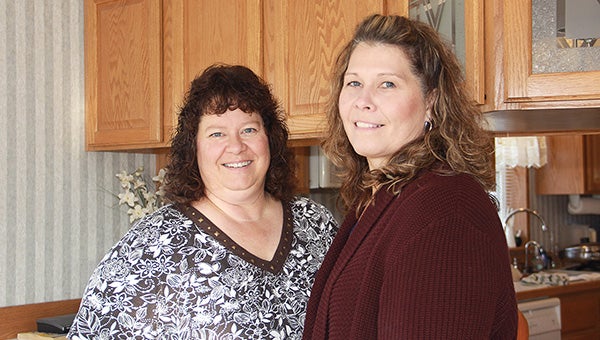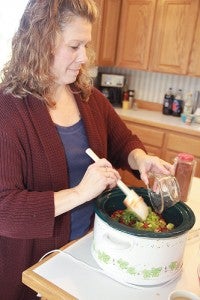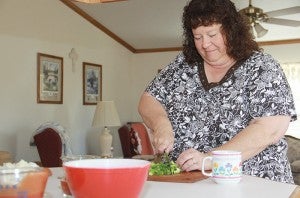Change of plans
Published 7:55 am Saturday, December 8, 2012

Sisters Cheryl Howard, left, and Linda Mullenbach, right, often spend time together in Cheryl’s kitchen in Hollandale preparing make-ahead meals together. That became more difficult after Linda’s husband, Jeff, was diagnosed with celiac disease. -- Jason Schoonover/Albert Lea Tribune
Two sisters eliminate gluten from their Thanksgiving menu
Scan almost any item in your pantry and you’ll find that it contains wheat or is made in a facility that processes wheat.

Linda Mullenbach pours green peppers into a gluten-free chili for her husband, Jeff, to eat on a hunting trip. Jeff was diagnosed with celiac disease and can’t process gluten. Though gluten is most commonly associated with wheat, barley and rye, it can be found in ingredients like tomato soup and beans. -- Jason Schoonover/Albert Lea Tribune
This wouldn’t normally be an issue — unless your husband was just diagnosed with celiac disease. Now imagine planning a Thanksgiving dinner, and you can understand the dilemma sisters Cheryl Howard and Linda Mullenbach faced a few years ago.
After Linda’s husband, Jeff, was diagnosed with celiac disease, the family had to change their menu. Celiac disease is a condition where a body can’t properly process gluten, a compound most commonly found in wheat, barley and rye.
Jeff’s newfound malady meant some changes were in order. He couldn’t enjoy the same foods he grew up on without issues, and it’s quite difficult to cut out specific grains from an everyday diet. This family had to be conscious of gluten possibly being in everything from the dinner rolls to the turkey and gravy.
Thanks to some smart shopping, family communication and a gluten-free type of flour to make gravy, the family substituted out almost all the gluten from the holiday meal without sacrificing the taste.
“No one even knew,” Cheryl said. Thanksgiving went off without a hitch for Cheryl, as she commonly hosts the holiday with her husband, Ron, at their Hollandale home.
A new dish
Though Linda and Jeff now live in Glencoe, cooking is still something the sisters do together, often in Cheryl’s large kitchen that offers plenty of space since it opens into the living room.
Linda and Cheryl will often meet to, as Cheryl describes it, “bake like crazy women” to prepare make-ahead meals. They’ll either cook and freeze a meal or combine the raw ingredients to cook later. That way, the family has a quick, easy meal if they’re busy later that week.
“We have a lot of fun in the kitchen,” Cheryl said.
But cooking became a bit more complex after Jeff’s celiac diagnosis.
Following a knee surgery, Jeff became sick with a chronic upset stomach, nausea and other issues that had doctors and family concerned.
“He lost like 35 pounds in four weeks,” Linda said. “It was something we were really looking at closely. They weren’t sure what it was at first.”

Cheryl Howard cuts green peppers for a gluten-free chili she and her sister, Linda Mullenbach, made for Linda’s husband, Jeff, who has celiac disease. -- Jason Schoonover/Albert Lea Tribune
A doctor at Glencoe Regional Health Services suggested it may be due to something he was eating. A blood test and a biopsy confirmed that his surgery had triggered celiac.
While gluten allergies are also common, celiac is different. It’s a condition where the body, particularly the intestines, can’t process and absorb gluten into the body.
“Your body can’t process that because you have an intolerance to gluten,” Linda said. “A lot of people think it’s an allergy, and it’s not.”
After the diagnosis, Linda found many foods around the kitchen Jeff could no longer eat.
Though gluten is mainly in wheat and grains, a host of products use wheat germ, from licorice to types of tomato soup.
“There are certain things you wouldn’t think have wheat in them, like licorice,” Linda said. “You have to be really careful when you read product labels.”
Linda started by using resources at Glencoe Regional Health Services. The Mullenbachs talked to a work colleague who had a relative with celiac, and they received a book and help from the Celiac Sprue Foundation.
“I started going through the book looking at what he could have and what he couldn’t have and what I could buy and what I couldn’t buy,” Linda said.
The gluten lookout
Armed with her research, Linda started by looking online for recipes, and she adjusted her own recipes however possible to remove gluten. In some recipes, Linda would substitute rice for bread crumbs, or she’d make gluten free bread. More types of gluten-free bread are becoming available now.
At first, seemingly commonplace routines like grocery shopping or going out to eat could be tedious. Along with reading many of the product labels at the grocery store, Linda had to also look for cross contamination. Many food companies produce multiple products, so something that doesn’t contain wheat could have been contaminated with small amounts from another product. That’s why many products say things like, “May contain traces of wheat,” or, “May contain traces of peanuts,” for peanut allergies.
Even sitting down to a meal at a restaurant proved difficult. Jim and Linda’s sons played hockey for many years, and it affected them when they would travel with tournaments and games. Unfortunately, steering clear of foods with gluten isn’t as simple as simply watching the menu.
“When you go traveling, you have to really be careful,” Linda said. “You can’t just go into a restaurant and order anything off the menu, because there’s cross-contamination.”
Linda said they often have to talk to a cook to make sure they’re not cooking on a grill that’s contaminated with buns or other foods that may have gluten.
However, the challenges faced by the family are easing, as gluten-free is gaining ground in the public’s consciousness.
“A lot of companies are coming up with products that are gluten-free,” Linda said.
Plus, those products taste better all the time. Jeff recently found a gluten-free bread he likes, while many gluten-free products tend to taste grainy or gritty.
After years of going gluten-free, Linda said it’s almost second-nature to her now when she shops, with Jeff having certain types of pasta, breads and products he can eat.
Holidays are back to a routine, too. At his first Thanksgiving with celiac, Jeff asked Cheryl what foods he could and could not eat. Now at Thanksgiving this year, Jeff can just dig in with the rest of the family.
“He knows when gets here, everything he sees he can eat — except the rolls,” Cheryl said.



